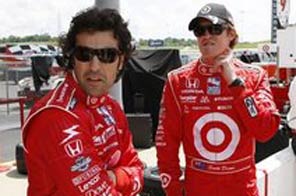IndyCar unveils "Press to Pass" at Kentucky
SPARTA: IndyCar has had it with the parades.
Following a string of largely uninspiring races, particularly on ovals, the open-wheel series is borrowing a page from video games in an effort to shake things up.
The series will unveil the "Push to Pass" button during Saturday night's race at Kentucky, one of a handful of changes officials hope provide more thrills and fewer yawns over the season's final six races.
Competitive racing has been almost nonexistent on the ovals, where the majority of the races have turned into nothing but two-hour processionals.
The circuit's last visit to an oval at Richmond in June featured so little passing drivers ended up apologizing to fans afterward.
"We've had some challenging races," said series points leader Scott Dixon, who will start from the pole at Kentucky after drainage problems wiped out qualifying Friday. "It's nice to see IndyCar react to it as fast as possible."
The boost button is akin to mashing the "X" button in a video game, only drivers will be doing it at 200 mph.
The button, which will be placed on the steering wheel, can be hit a maximum of 20 times during a race. Each boost will last 12 seconds and give the driver up to 20 extra horsepower depending on the car's fuel mixture. The more fuel a driver is trying to save, the bigger the push.
"Obviously we want to put on a good show and win the race as well," Dixon said. "If it does that and achieves that then I think we've done a good job."
The unveiling, however, could be tricky.
Drainage problems at Kentucky's 1.5-mile oval following a series of storms earlier this week kept cars off the track on Friday, meaning drivers will have just one practice session on Saturday to play with their new toys before seeing the green flag.
"I'm just going to push that thing and see what happens," said Dario Franchitti. "My button is going to have a smiley face on it."
The series made several other changes to the car, including modifying the rear wing to provide more efficient downforce while removing drag, making it easier for cars to draft each other.
Bringing the cars closer together should help solve the lack of passing, which Dixon said was the result of teams having too little wiggle room with the way the cars are set up.
If you have a field full of 24 cars put together almost identically, that makes it difficult to find the little extra bit of speed needed to dart under an opponent.
"It's hard to get an advantage to pass somebody if you're not any different from them and your car is going to go off in the same way," he said. "Even 10 or 20 or 40 laps into a run it's been tough."
The additional downforce should allow drivers to run in multiple grooves, something that's been decidedly lacking this season. Kentucky has a reputation for side-by-side racing, and the extra downforce should encourage them to take their chances.
"I think it's safer to race like that than to be on the edge and be sliding up the track into each other," Danica Patrick said.
There will be a 10-second blackout following each boost, meaning drivers can't simply keep hitting the button late in the race in hopes of making up ground.
It will also provide teams with an interesting dilemma: do they use the boost early in the race to help make up ground or do they save it for the final laps when track position will be at a premium.
"I think there's going to be a little trial and error with it," Dixon said.
Thrills have never been the problem at Kentucky, which has produced some of the more exciting finishes in series history. Dixon picked up his first win at the track last year when he sneaked past Helio Castroneves on the final lap after Castroneves ran out of fuel.
Don't expect, however, a little button pushing to solve everything.
"It's not like you're going to press it and it's going to become a rocket ship," said Sarah Fisher, who is making her first start in six weeks. "It's just kind of a booster. It will give you a little bit but it's not going to give you the wherewithal to make a no-brainer pass. You're still going to have to do some driving to pull that off."






